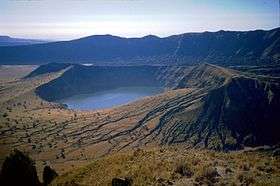Marrah Mountains
| Marrah Mountains | |
|---|---|
| Jebel Marra | |
 Inner and outer crater, Deriba Crater | |
| Highest point | |
| Peak | Deriba crater |
| Elevation | 3,042 m (9,980 ft) |
| Coordinates | 12°57′00″N 24°16′12″E / 12.95000°N 24.27000°ECoordinates: 12°57′00″N 24°16′12″E / 12.95000°N 24.27000°E |
| Geography | |
| Country | Sudan |
| State/Province | Darfur |
| Geology | |
| Type of rock | Volcanic field |
The Marrah Mountains or Marra Mountains (Fur, Fugo Marra; Arabic: جبل مرة, Jebel Marra “bad mountains”) is a range of volcanic peaks created by a massif that rises up to 3,042 metres (9,980 ft). It is located in the center of the Darfur region of Sudan, specifically on the border of the states of South Darfur and Central Darfur, with a smaller part of the range in the state of North Darfur. The highest point is Deriba Caldera. The upper reaches of the massif is a small area of temperate climate with high rainfall and permanent springs of water amidst the dry savanna and scrub of the Sahel below.[1]
Apart from the Aïr Mountains in Niger which are on the border of the Sahara proper, the Marrah Mountains are the only major mountain range in the otherwise flat Sahel, rising up to 2,600 metres (8,500 ft) above the plain, but are owing to lack of development and political conflict exceedingly badly known.
The last eruption occurred around 1500 BC. The centre of activity was Deriba Caldera, and involved caldera collapse following the eruption of pumice and pyroclastic flows which travelled over 30 kilometres (19 mi) from the volcano.[2] The most prominent feature of the vast Jebel Marra volcanic field, located in the Darfur province of western Sudan, is the youthful Deriba caldera. The 5-km-wide, steep-walled caldera, located at the southern end of the volcanic field, was formed about 3500 years ago at the time of the eruption of voluminous airfall pumice and pyroclastic flows that traveled more than 30 kilometres (19 mi) from the actual volcano. The Jebel Marra volcanic field covers a broad area of the Marra Mountains and contains early basaltic lava flows overlain by thick sequences of pyroclastic-flow deposits. The northern part of the volcanic field displays trachytic lava plugs and spines forming residual inselbergs and young basaltic scoria cones and lava flows. Ash eruptions at Deriba caldera may have continued into early historical time (Burton and Wickers, 1966), and fumarolic activity has been observed on the flanks of a small pyroclastic cone within the caldera.
Footnotes
- ↑ de Waal, Alex, Famine that Kills: Darfur, Sudan, Oxford University Press (Revised edition), 2005, ISBN 0-19-518163-8, p. 36
- ↑ "Jebel Marra: Eruptive History". Global Volcanism Program. Smithsonian Institution.